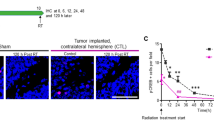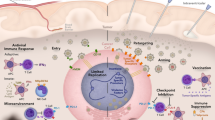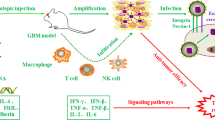Abstract
The long-term consequences of adenovirus-mediated conditional cytotoxic gene therapy for gliomas remain uncharacterized. We report here detection of active brain inflammation 3 months after successful inhibition of syngeneic glioma growth. The inflammatory infiltrate consisted of activated macrophages/microglia and astrocytes, and T lymphocytes positive for leucosyalin, CD3 and CD8, and included secondary demyelination. We detected strong widespread herpes simplex virus 1 thymidine kinase immunoreactivity and vector genomes throughout large areas of the brain. Thus, patient evaluation and the design of clinical trials in ongoing and future gene therapy for brain glioblastoma must address not only tumor-killing efficiency, but also long-term active brain inflammation, loss of myelin fibers and persistent transgene expression.
This is a preview of subscription content, access via your institution
Access options
Subscribe to this journal
Receive 12 print issues and online access
$209.00 per year
only $17.42 per issue
Buy this article
- Purchase on Springer Link
- Instant access to full article PDF
Prices may be subject to local taxes which are calculated during checkout







Similar content being viewed by others
References
Izquierdo, M. et al. Human malignant brain tumour response to herpes simplex tymidine kinase (HSVtk)/ganciclovir gene therapy. Gene Therapy 3, 491–495 (1996).
Ram, Z. et al. Therapy of malignant brain tumors by intratumoral implantation of retroviral vector-producing cells. Nature Medicine 3, 1354–1361 (1997).
Klatzmann, D. et al. A phase I/II study of herpes simplex virus type 1 thymidine kinase "suicide" gene therapy for recurrent glioblastoma. Hum. Gene Ther. 9, 2595–2604 (1998).
Eck, S.L. et al. Treatment of advanced CNS malignancies with the recombinant adenovirus H5.010RSVTK: a phase I trial. Hum. Gene Ther. 7, 1465–1482 (1996).
Freeman, S. et al. The "bystander effect": tumour regression when a fraction of the tumour mass is genetically modified. Cancer Res. 53, 5274–5283 (1993).
Freeman, S.M., Ramesh, R. & Marrogi, A.J. Immune system in suicide gene therapy. Lancet 349, 2–3 ( 1997).
Gagandeep, S. et al. Prodrug-activated gene therapy: involvement of an immunological component in the "bystander effect". Cancer Gene Ther. 3, 83–88 (1996).
Barba, D., Hardin, J., Sadelain, M. & Gage, F. Development of anti-tumor immunity following thymidine kinase-mediated killing of experimental brain tumors. Proc. Natl. Acad. Sci. USA 91, 4348 –4352 (1994).
Beck, C., Cayeux, S., Lupton, S., Dorken, B. & Blankenstein, T. The thymidine kinase/ganciclovir-mediated "suicide" effect is variable in different tumour cells. Hum. Gene Ther. 6, 1525–1530 (1995).
Chen, S.-H., Shine, H.D., Goodman, J., Grossman, R. & Woo, S.L.C. Gene therapy for brain tumors: regression of experimental gliomas by adenovirus-mediated gene transfer in vivo. Proc. Natl. Acad. Sci. USA 91, 3054–3057 (1994).
Culver, K. et al. In vivo gene transfer with retroviral vector-producer cells for treatment of experimental brain tumors. Science 256, 1550–1552 (1992).
Ezzeddine, Z. et al. Selective killing of glioma cells in culture and in vivo by retrovirus transfer of the herpes simplex virus thymidine kinase gene. New Biologist 3, 608–614 (1991).
Izquierdo, M. et al. Long-term rat survival after malignant brain tumor regression by retroviral gene therapy. Gene Ther. 2, 66–69 (1995).
Maron, A. et al. Gene therapy of rat C6 glioma using adenovirus-mediated transfer of the herpes simplex virus thymidine kinase gene: long-term follow-up by magnetic resonance imaging. Gene Therapy 3, 315–322 (1996).
Perez-Cruet, M. et al. Adenovirus-mediated gene therapy of experimental gliomas. J. Neurosci. Res. 39, 506– 511 (1994).
Ram, Z. et al. The effect of thymidine kinase transduction and ganciclovir therapy on tumor vasculature and growth of 9L giomas in rats. J. Neurosurg. 81, 256–260 ( 1994).
Ambar, B.B. et al. Treatment of experimental glioma by administration of adenoviral vectors expressing Fas ligand. Hum. Gene Ther. 10, 1641–1648 (1999).
Byrnes, A.P., Rusby, J.E., Wood, M.J.A. & Charlton, H.M. Adenovirus gene transfer causes inflammation in the brain. Neuroscience 66, 1015–1024 ( 1995).
Byrnes, A.P., MacLaren, R.E. & Charlton, H.M. Immunological instability of persistent adenovirus vectors in the brain: peripheral exposure to vector leads to renewed inflammation, reduced gene expression, and demyelination. J. Neurosci. 16, 3045–3055 (1996).
Cartmell, T. et al. IL-1 mediates a rapid inflammatory response following adenoviral vector delivery into the brain. J. Neurosci. 19, 1517–1523 (1999).
Geddes, B.J., Harding, T.C., Lightman, S.L. & Uney, J.B. Long-term gene therapy in the CNS: reversal of hypothalamic diabetes insipidus in the Brattleboro rat by using an adenovirus expressing arginine vasopressin. Nature Med. 3, 1402–1404 (1997).
Ghodsi, A. et al. Extensive β-glucuronidase activity in murine central nervous system after adenovirus-mediated gene transfer to brain. Hum. Gene Ther. 9, 2331–2340 (1998).
Blomer, U., Naldini, L., Kafri, T., Trono, D., Verma, I.M. & Gage, F.H. Highly efficient and sustained gene transfer in adult neurons with a lentivirus vector. J. Virol 71, 6641–6649 ( 1997).
Hermens, W.T. & Verhaagen, J. Suppression of inflammation by dexamethasone prolongs adenoviral vector-mediated transgene expression in the facial nucleus of the rat. Brain Res. Bull. 47,133–40 (1998).
Kruse, C.A. et al. A rat glioma model, CNS-1, with invasive characteristics similar to those of human gliomas: a comparison to 9L gliosarcoma. J. Neurooncol. 22, 191–200 ( 1994).
Salomon, B et al. A truncated herpes simplex virus thymidine kinase phosphorylates thymidine and nucleoside analogs and does not cause sterility in transgenic mice. Mol. Cell. Biol. 15, 5322– 5328 (1995).
Dewey, R.A. et al. Adenoviral-mediated suicide gene therapy using the CNS-1 rat glioma model. Abstr. Soc. Neurosci. Part 2 2165, number 859.9 (1998).
Goodman, J. et al. Adenoviral-mediated thymidine kinase gene transfer into the primate brain followed by systemic ganciclovir: pathologic, radiologic, and molecular studies. Hum. Gene Ther. 7, 1241 –1250 (1996).
Smith, J. et al. Intracranial administration of adenovirus expressing HSV-TK in combination with ganciclovir produces a dose-dependent, self-limiting inflammatory response. Hum. Gene Ther. 8, 943– 954 (1997).
Puumalainen, A. et al. Beta-galactosidase gene transfer to human malignant glioma in vivo using replication-deficient retroviruses and adenoviruses. Hum. Gene Ther. 9, 1769–1774 (1998).
Klinkert, W.E. et al. TNF-alpha receptor fusion protein prevents experimental auto-immune encephalomyelitis and demyelination in Lewis rats: an overview. J. Neuroimmunol. 72, 163–168 (1997).
Weller, M. & Fontana, A. The failure of current immunotherapy for malignant glioma. Tumor-derived TGF-beta, T-cell apoptosis, and the immune privilege of the brain. Brain Res. Brain Res. Rev. 21, 128–151 (1995).
Gratas et al. Fas ligand expression in glioblastoma cell lines and primary astrocytic brain tumours. Brain Pathol. 7, 863– 869 (1997).
Easton, R.M., Johnson, E.M. & Creedon, D.J. Analysis of events leading to neuronal death after infection with E1-deficient adenoviral vectors. Mol. Cell. Neurosci. 11, 334–347 ( 1998).
Shering, A.F. & Lowenstein, P.R. Neocortex provides direct synaptic input to interstitial neurons of the intermediate zone of kittens and white matter of cats: a light and electron microscopic study. J. Comp. Neurol. 347, 433–443 ( 1994).
Morelli, A. et al. Reduced systemic toxicity of recombinant adenovirus vectors expressing the apoptotic molecule Fas-L driven by cell-type specific promoters. J. Gen. Virol. 80, 571– 583 (1999).
Shering, A.F. et al. Cell-type specific expression in brain cell cultures from a short human cytomegalovirus major immediate early promoter depends on whether it is inserted into herpesvirus or adenovirus vectors. J. Gen. Virol. 78, 445–459 ( 1997).
Cotten, M., Baker, A., Saltik, M., Wagner, E. & Buschle, M. Lipopopysaccharide is a frequent contamination of plasmid DNA preparations and can be toxic to primary human cells in the presence of adenovirus. Gene Ther. 1, 239– 246 (1994).
Hauss-Wgrzyniak, B., Lukovic, L., Bigaud, M. & Stoeckel, M.E. Brain inflammatory response induced by intracerebroventricular infusion of lipopolysaccharide: an immunohistochemical study. Brain Res. 794, 211–224 (1998).
Dion, D. L., Fang, J. & Garver Jr., R. I. Supernatant rescue assay vs. polymerase chain reaction for detection of wild type adenovirus-contaminating recombinant adenovirus stocks. J. Virol. Meth. 56:99 –107 (1996).
Lowenstein, P.R., Shering, A.F., James, J.L., Cohen, P. & McDougall, L. The distribution of protein phosphatase inhibitor, Inhibitor 1, in the neocortex of the cat, ferret, and rat: a light and electron microscopical study. Brain Res. 676, 80–92 (1995).
Wolff, SD & Balaban, RS. Magnetization transfer contrast (MTC) and tissue water proton relaxation in vivo. Magn. Reson. Med. 10, 135–144, 1989.
Wolff, S.D. & Balaban, R.S. Magnetization transfer imaging: practical aspects and clinical applications. Radiology 192, 593–599, 1994.
Kurki, T., Lundbom, N., Kalimo, H. & Valtonen, S. MR classification of brain gliomas: value of magnetization transfer and conventional imaging. Magn. Reson. Imaging 13, 501– 511 (1995).
Lee, K.H. & Contache, D.A. Detection of β-actin mRNA by RT-PCR in normal and regenerating chicken cochleae. Hearing Res. 87, 9–15 ( 1995).
Acknowledgements
The technical assistance of T. Maleniak and the secretarial help of Ros Poulton, are acknowledged. We also thank I. Miller and T. Bentley from the Electron Microscopy, Photography and Graphics Unit (School of Biological Sciences, University of Manchester) for their help and advice with the final production of the figures. Comments on the work and manuscript by D. Mann, and P. Kingston are acknowledged. This work was supported by Cancer Research Campaign, UK (project grant number SP2332/0101 to P.R.L. and M.G.C.), and European Community Biomed II grant to P.R.L., M.G.C. and D.K. (Contract number BMH4-CT96-1436). T.D.S. is an Action Research Training Fellow, and P.R.L. is a Research Fellow of The Lister Institute of Preventive Medicine.
Author information
Authors and Affiliations
Corresponding authors
Rights and permissions
About this article
Cite this article
Dewey, R., Morrissey, G., Cowsill, C. et al. Chronic brain inflammation and persistent herpes simplex virus 1 thymidine kinase expression in survivors of syngeneic glioma treated by adenovirus-mediated gene therapy: Implications for clinical trials. Nat Med 5, 1256–1263 (1999). https://doi.org/10.1038/15207
Received:
Accepted:
Issue Date:
DOI: https://doi.org/10.1038/15207
This article is cited by
-
Development of a stable Sf9 insect cell line to produce VSV-G pseudotyped baculoviruses
Gene Therapy (2024)
-
Suicide gene therapy using allogeneic adipose tissue-derived mesenchymal stem cell gene delivery vehicles in recurrent glioblastoma multiforme: a first-in-human, dose-escalation, phase I clinical trial
Journal of Translational Medicine (2023)
-
Live-cell imaging of circadian clock protein dynamics in CRISPR-generated knock-in cells
Nature Communications (2021)
-
Convection-enhanced drug delivery for glioblastoma: a review
Journal of Neuro-Oncology (2021)
-
A highly efficient non-viral process for programming mesenchymal stem cells for gene directed enzyme prodrug cancer therapy
Scientific Reports (2020)



